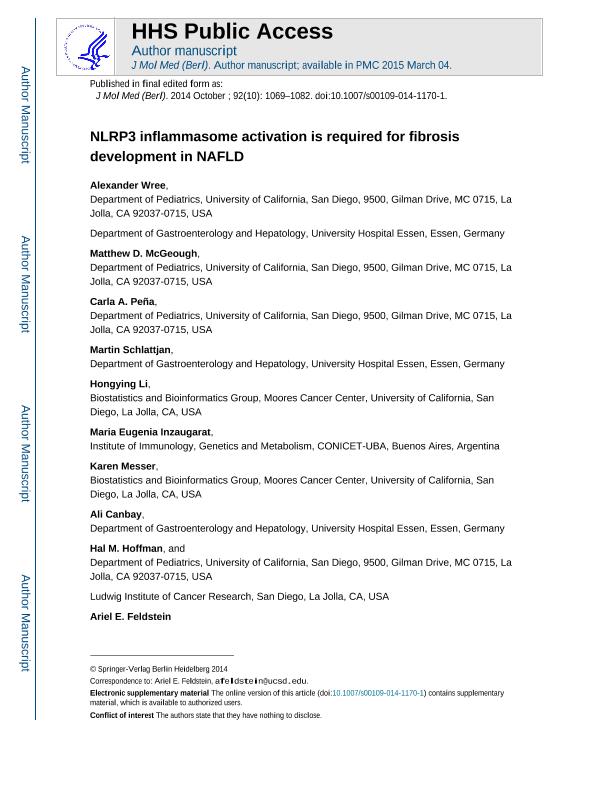Artículo
NLRP3 inflammasome activation is required for fibrosis development in NAFLD
Wree, Alexander; McGeough, Matthew D.; Peña, Carla A.; Schlattjan, Martin; Li, Hongying; Inzaugarat, Maria Eugenia ; Messer, Karen; Canbay, Ali; Hoffman, Hal M.; Feldstein, Ariel E.
; Messer, Karen; Canbay, Ali; Hoffman, Hal M.; Feldstein, Ariel E.
 ; Messer, Karen; Canbay, Ali; Hoffman, Hal M.; Feldstein, Ariel E.
; Messer, Karen; Canbay, Ali; Hoffman, Hal M.; Feldstein, Ariel E.
Fecha de publicación:
10/2014
Editorial:
Springer Verlag Berlín
Revista:
Journal of Molecular Medicine (Berlin, Germany)
ISSN:
0946-2716
e-ISSN:
1432-1440
Idioma:
Inglés
Tipo de recurso:
Artículo publicado
Clasificación temática:
Resumen
NLR inflammasomes, caspase 1 activation platforms critical for processing key pro-inflammatory cytokines, have been implicated in the development of nonalcoholic fatty liver disease (NAFLD). As the direct role of the NLRP3 inflammasome remains unclear, we tested effects of persistent NLRP3 activation as a contributor to NAFLD development and, in particular, as a modulator of progression from benign hepatic steatosis to steatohepatitis during diet-induced NAFLD. Gain of function tamoxifen-inducible Nlrp3 knock-in mice allowing for in vivo temporal control of NLRP3 activation and loss of function Nlrp3 knockout mice were placed on short-term choline-deficient amino acid-defined (CDAA) diet, to induce isolated hepatic steatosis or long-term CDAA exposure, to induce severe steatohepatitis and fibrosis, respectively. Expression of NLRP3 associated proteins was assessed in liver biopsies of a well-characterized group of patients with the full spectrum of NAFLD. Nlrp3−/− mice were protected from long-term feeding CDAA-induced hepatomegaly, liver injury, and infiltration of activated macrophages. More importantly, Nlrp3−/− mice showed marked protection from CDAA-induced liver fibrosis. After 4 weeks on CDAA diet, wild-type (WT) animals showed isolated hepatic steatosis while Nlrp3 knock-in mice showed severe liver inflammation, with increased infiltration of activated macrophages and early signs of liver fibrosis. In the liver samples of patients with NAFLD, inflammasome components were significantly increased in those patients with nonalcoholic steatohepatitis (NASH) when compared to those with non-NASH NAFLD with mRNA levels of pro-IL1 beta correlated to levels of COL1A1. Our study uncovers a crucial role for the NLRP3 inflammasome in the development of NAFLD. These findings may lead to novel therapeutic strategies aimed at halting the progression of hepatic steatosis to the more severe forms of this disease.
Palabras clave:
Nlrp3
,
Inflammation
,
Liver Fibrosis
,
Nash
,
Steatoheptatisis
Archivos asociados
Licencia
Identificadores
Colecciones
Articulos(INIGEM)
Articulos de INSTITUTO DE INMUNOLOGIA, GENETICA Y METABOLISMO
Articulos de INSTITUTO DE INMUNOLOGIA, GENETICA Y METABOLISMO
Citación
Wree, Alexander; McGeough, Matthew D.; Peña, Carla A.; Schlattjan, Martin; Li, Hongying; et al.; NLRP3 inflammasome activation is required for fibrosis development in NAFLD; Springer Verlag Berlín; Journal of Molecular Medicine (Berlin, Germany); 92; 10; 10-2014; 1069-1082
Compartir
Altmétricas



